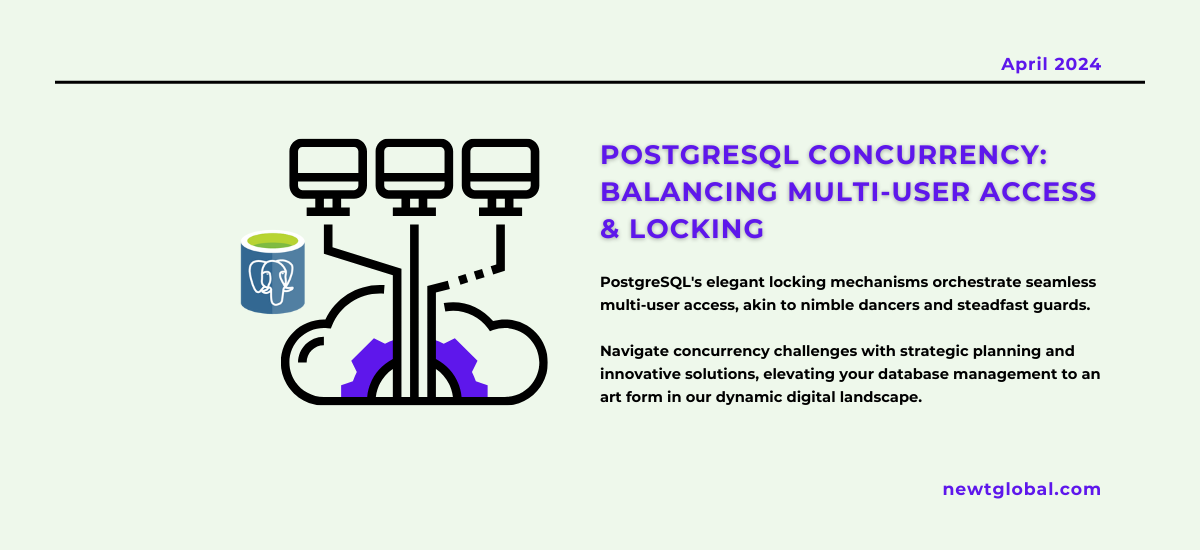
In the big and always-changing world of managing databases, being able to let many people use and change information at the same time is very important. It’s like an art. PostgreSQL is good at this. It uses a smart system of locks to keep data safe and consistent, doing it so well that it looks easy. Let’s dive into how PostgreSQL handles many users at once with style and accuracy.
Unlocking the Mysteries of PostgreSQL Locking Mechanisms
PostgreSQL uses different kinds of locks to manage data when lots of people are using it at once. These locks work together in two main types: locks for individual rows of data, which are like nimble dancers making sure everything moves smoothly, and locks for whole tables, which are like strong guards keeping everything in order.
-
- Row-Level Locks: These help PostgreSQL use a special system to let people read data without getting in each other’s way, making everything run smoother.
-
- Table-Level Locks: These make sure that when you’re working with tables, everything stays organized and safe, either automatically during regular work or on purpose when you tell it to.
Navigating the Labyrinth of Concurrency Challenges
Figuring out and fixing problems when many people are using the database at the same time can be tricky. You might run into slowdowns or even parts of the database that lock up completely. But, by using tools like pg_stat_activity and EXPLAIN ANALYZE, you can shine a light on these issues, seeing exactly where and why they’re happening.
Here are some smart moves to avoid problems:
-
- Plan your database layout like a wise old guide, making sure everything flows well.
-
- Make transactions short and efficient to avoid traffic jams.
-
- Pick the right settings for balancing speed and accuracy.
Strategies for Elevating Concurrency to an Art Form
To turn the challenge of many users into something beautiful, you need both knowledge and creativity.
-
- Indexing: Make getting to your data easier and quicker, which helps everything run more smoothly.
-
- Partitioning: Split up big sets of data so that locks don’t get in each other’s way.
-
- Improving Application Logic: Sometimes, rethinking how your application works can make everything run better, reducing conflicts and making batch operations smoother.
The Oracle’s Tools for Monitoring and Troubleshooting
To keep everything running smoothly, use tools like pg_locks and pg_stat_locks, along with other ways to monitor your database. These help you see problems before they get big, letting you fix them early.
When you do run into lock issues, tackle them head-on. Look closely at what’s happening, make your indexes better, and adjust your transactions to get everything back in sync.
Closing Thoughts
Mastering the art of handling many users in PostgreSQL is about exploring, innovating, and making things work beautifully together. With the right approach, tools, and thinking, database pros can manage the complexities of locks and multiple users, making sure their applications run smoothly in our digital world.
Our guide unlocks the secrets of PostgreSQL’s locking mechanisms, empowering you to navigate the complexities of concurrency with ease. Newt Global DMAP is a world-class product enabling mass migration of Oracle Db to cloud-native PostgreSQL faster, better, and cheaper.
Visit newtglobal.com to uncover the features, benefits, and success stories of the Newt Global DMAP. Dive deep into how our solution can cater to your specific needs, ensuring a smooth migration path tailored just for you. Have questions or need guidance? Don’t hesitate to reach out to us at marketing@newtglobalcorp.com. Our team of experts is on standby to assist you with any inquiries, provide detailed insights, and help you navigate your migration journey with confidence.
